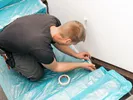By continuing to use this site, you agree to our use of cookies.
How to Protect Your Floors During a Move
Sep 4, 2024
Do you have to cover the floors when moving?
On moving day, your floors will likely get more traffic than any other time of year. That’s why it’s especially important to protect them from damage. The best way to do this is to cover them, but how?
While it takes some extra work during an already hectic time, keeping floors safe from scratches, dents, dirt and mud is worth the effort.
Keep reading to learn how to keep floors in tip-top shape while moving in or out of a home.

Steps for protecting floors
For all types of flooring, start with these easy steps to protect it during a move:
1. Clean
Even though you’ll likely track in some dirt when loading or unloading, start with clean surfaces so nothing gets trapped under coverings or ground into carpet or tile.
2. Measure the area
Measure high-traffic paths through your home to determine the linear feet of floor covering you’ll need.
3. Put down a doormat
Place a heavy doormat near the exits and ask everyone to wipe their feet between trips outside. Lightweight mats can be a tripping hazard, so it's best to avoid them.
4. Use floor covering
One of the best ways to protect floors is to cover them, especially in high-traffic areas like hallways and entryways.
Use the guide below to determine the best option for each area.
5. Split crews into indoor and outdoor teams
Separate your moving labor into two groups if possible. One group stays inside, taking items to or from the doorway, and the other remains outside, taking things from the home to the moving equipment (or in reverse when unloading). This will help keep tracked-in dirt to a minimum.
6. Have a plan for loading heavy appliances and furniture
We recommend putting down cardboard or a sheet of floor covering before moving appliances or furniture away from the walls. Then, use a dolly to load and unload large pieces to avoid dropping or dragging them.
It's also important to plan where to safely set things down if you need to rest while loading. Knowing ahead of time can help reduce excess shifting that can cause damage.
Use our loading tips to learn how to move heavy items safely.
Guide for choosing the best moving floor protection
Products designed specifically for covering floors will provide the most protection and be safest for people walking around carrying loads. While you can use rugs, old blankets or drop cloths, those can be tripping hazards and are best to avoid if possible.
Most cover options can be found at a hardware store. While you're there, grab some blue painter’s tape to help secure it!
Hardwood floors
You have a couple of options for protecting hardwood while moving appliances and furniture.
Red rosin paper is the most affordable and provides a layer of protection against wear and tear. However, the best protection for prefinished hardwood is a product called Floor Shield®. It’s thicker than the red rosin paper, non-slip and self-adhering, so it’s protective and easy to put down.
Note: For job-finished or manufactured wood, which has a more delicate finish, we recommend using builder’s paper or X-Board® for the best level of protection.
Carpet
The best and easiest way to cover carpets when moving is to use an adhesive poly sheet called carpet film.
Apply it as you would plastic wrap — unroll and step on it to stick it to the floor. It doesn’t leave a residue when applied for a short time, and it will prevent stains or damage to both cut- and looped-pile carpets.
Vinyl
Scuffs and tears are the biggest concern with vinyl flooring, so be sure to lay down cardboard if you’re going to scoot appliances or furniture over them. Otherwise, protect the finish by laying down red rosin paper and attaching it with blue painter’s tape.
Tile
You want something sturdy to prevent broken or cracked tiles when moving. We recommend X-Board for high-traffic tiled areas and Ram Board® for pathways where you’ll be taking a dolly across. While it’s the most expensive option, it provides the thickest protection when rolling heavy items on fragile tile floors.
Stairs
It takes a little work to cover a set of stairs, but it will be worth it since they will see a lot of traffic during a move. Use carpet film over carpeted stairs and red rosin paper over every other type of flooring since it’s flexible and easiest to custom fit. Be sure to tape the paper down sufficiently to avoid any tripping hazards.
Questions?
If you have questions about protecting your floors during a move, let us know in the comments. We’re here to help!
More articles you might like...



